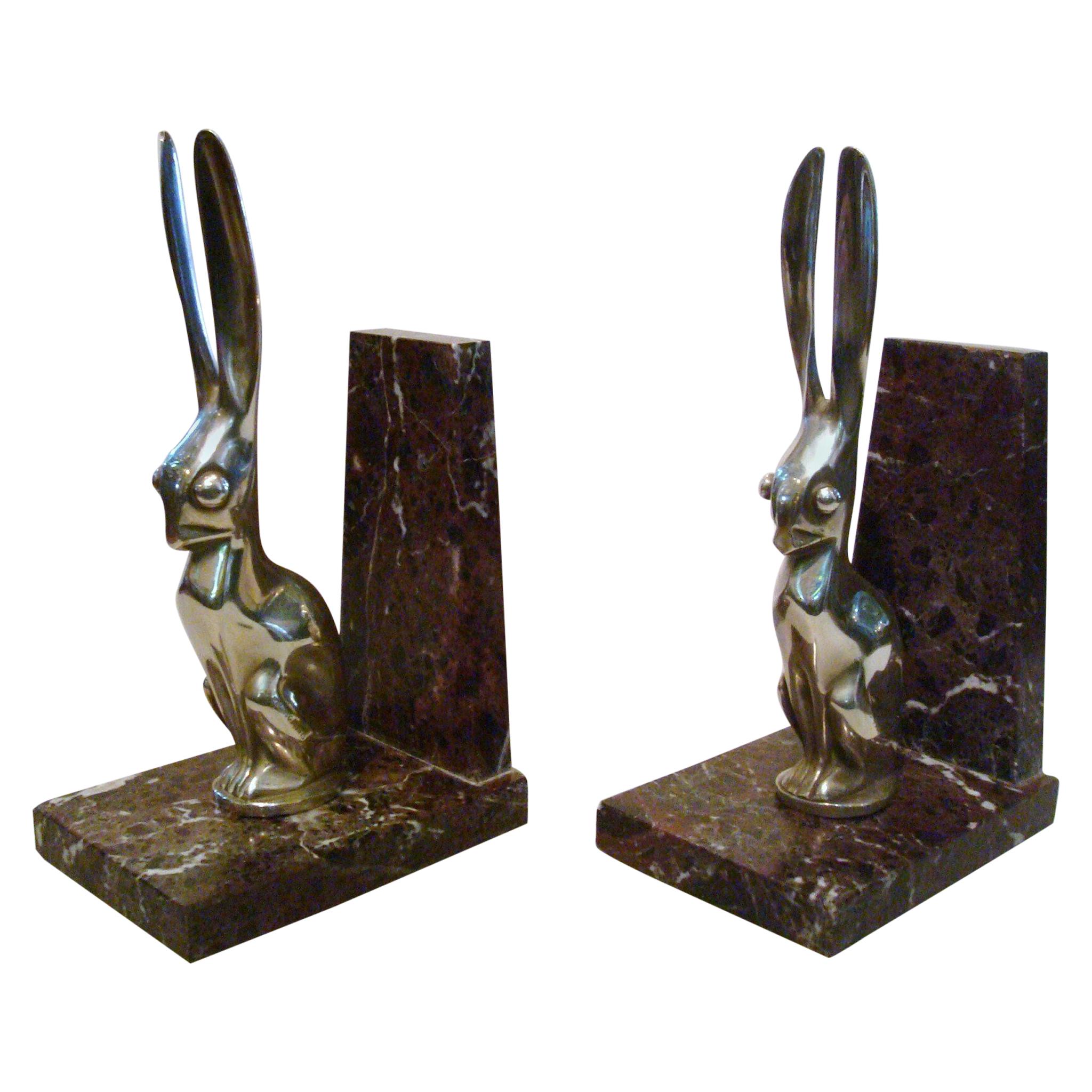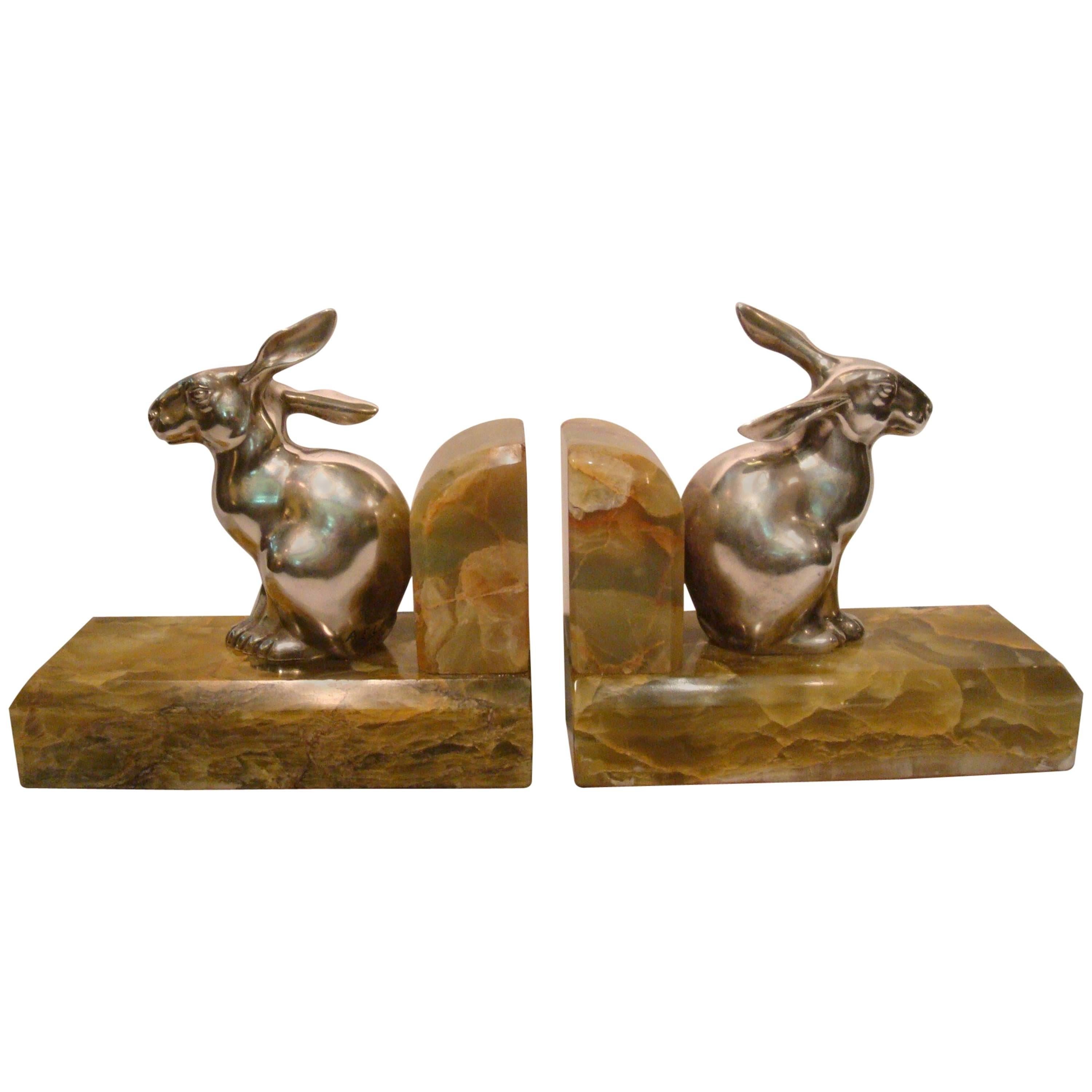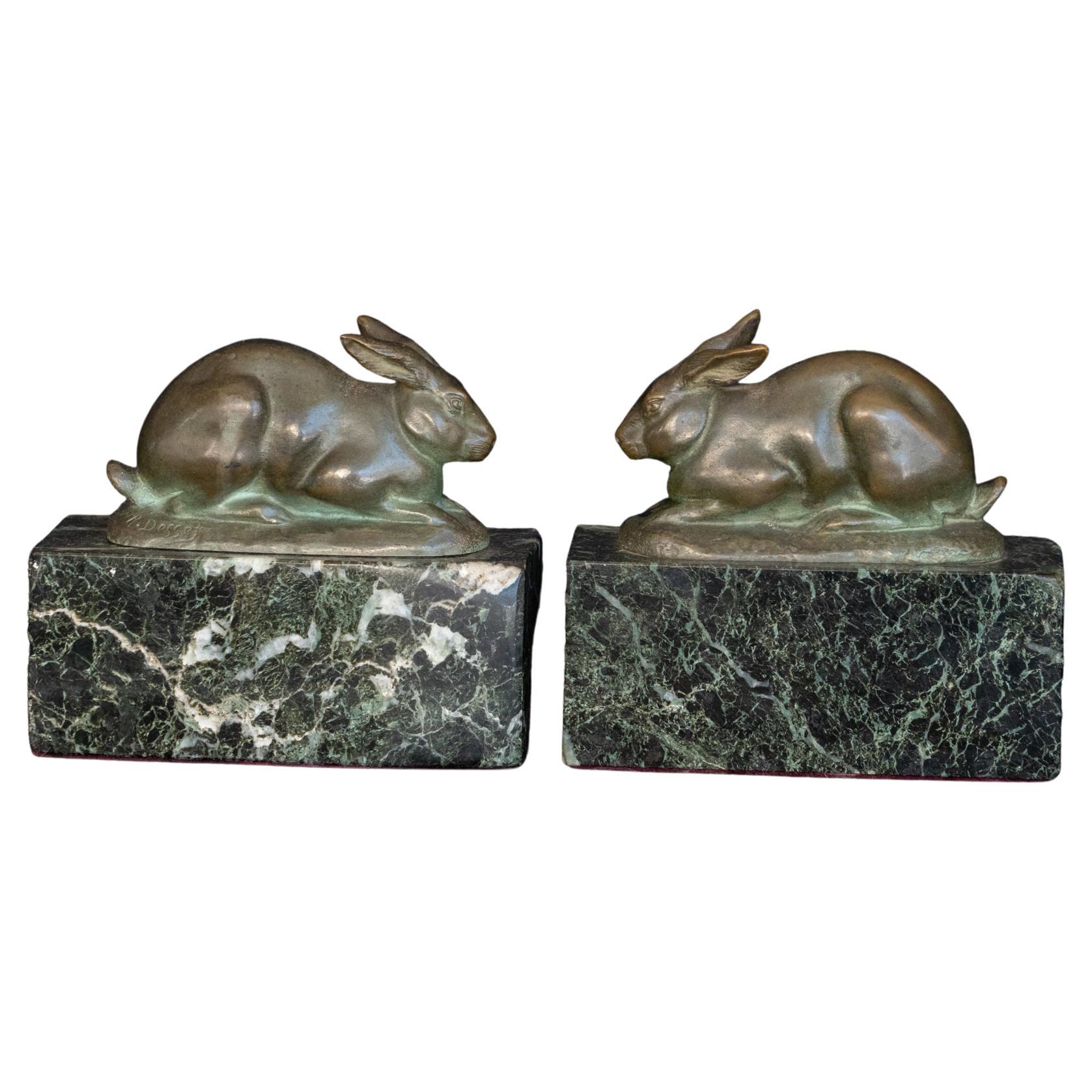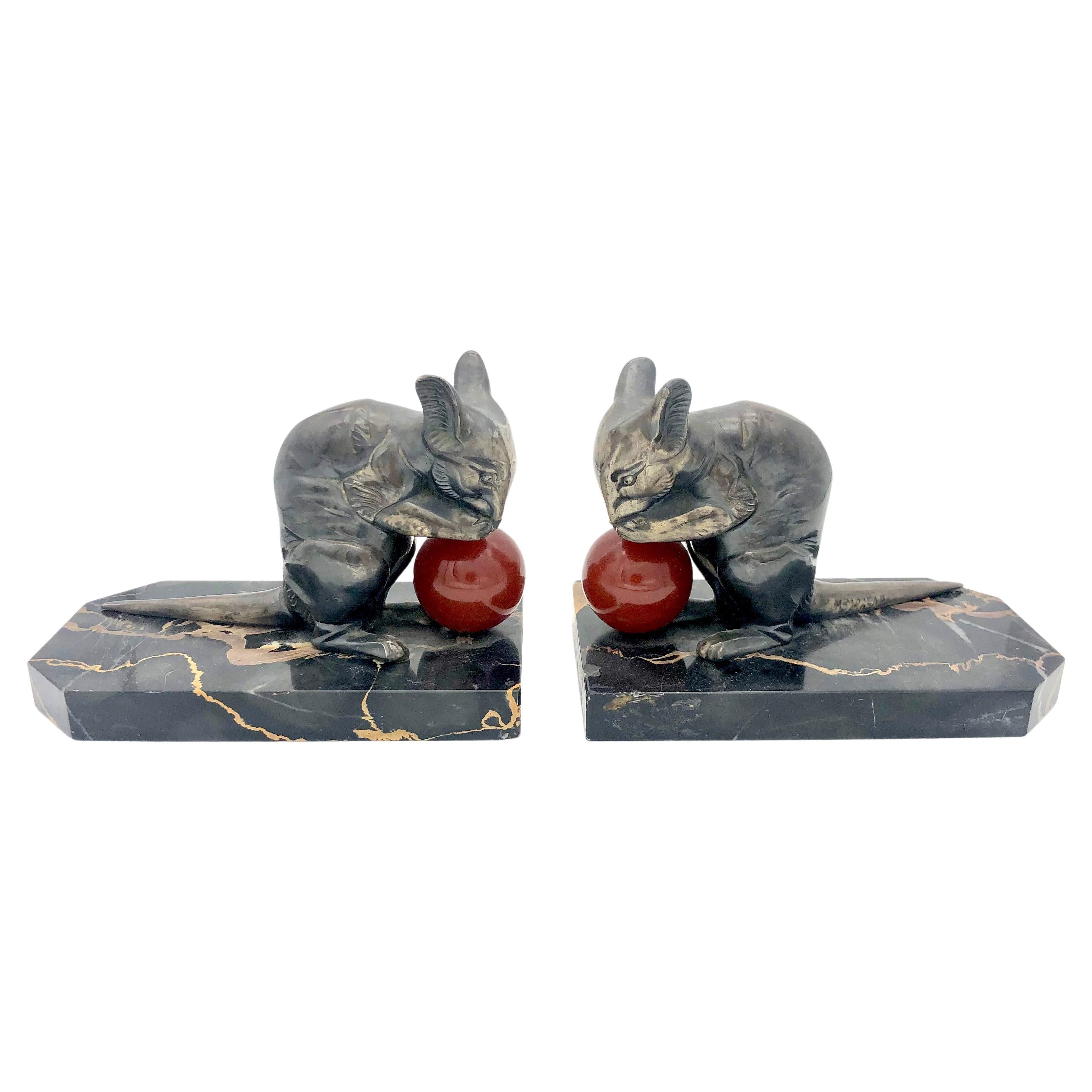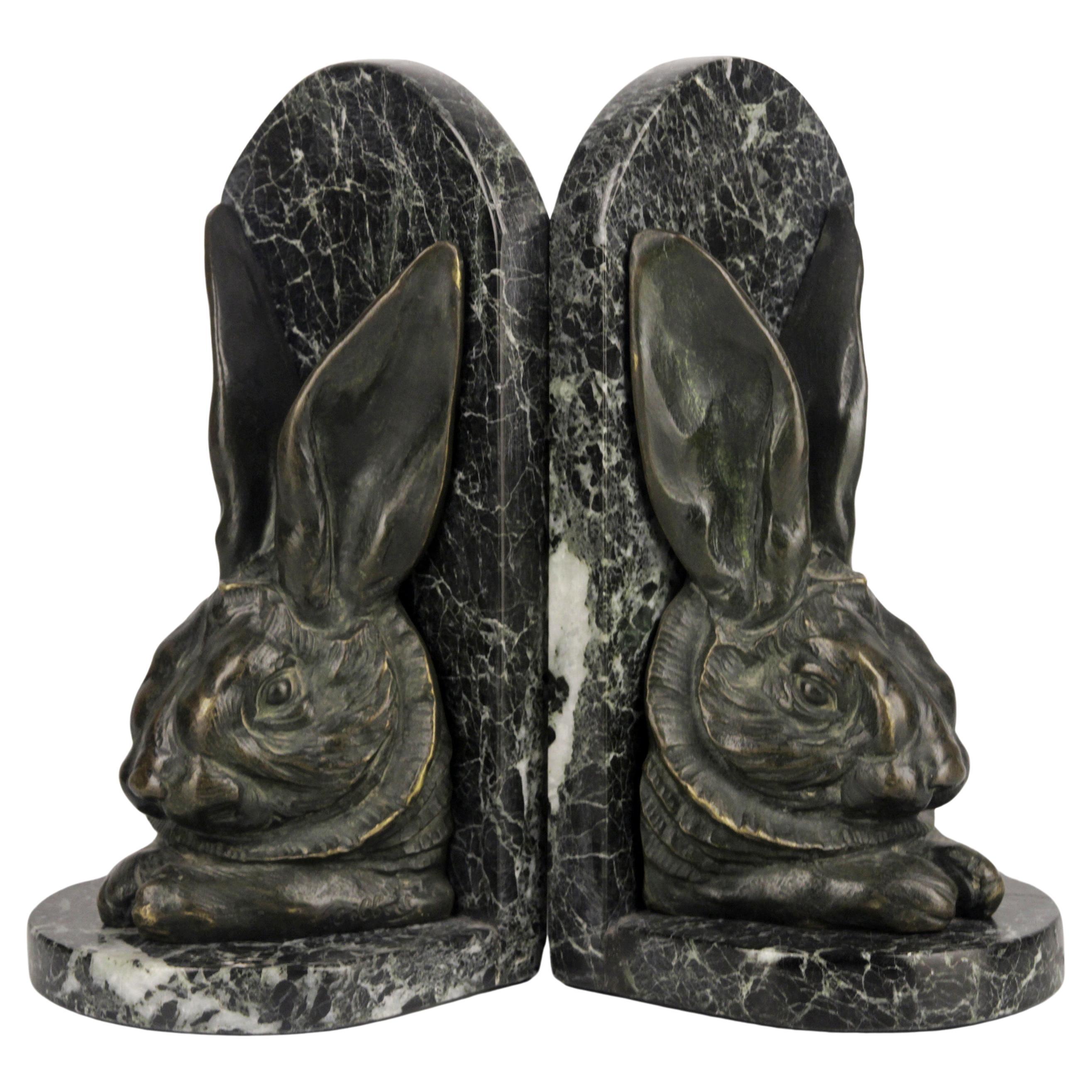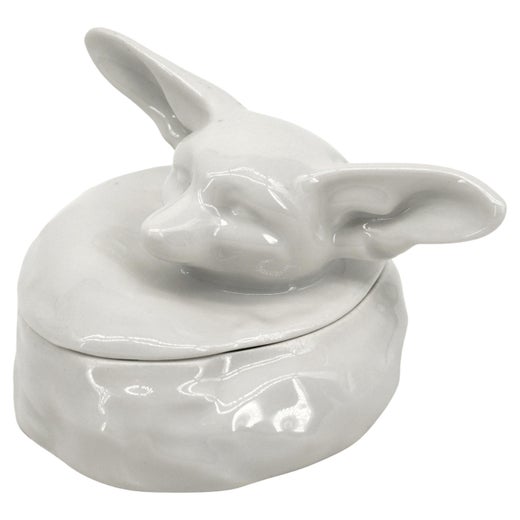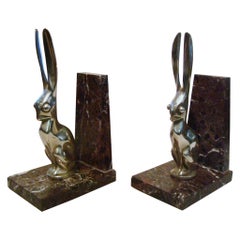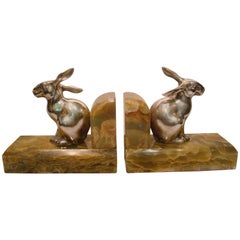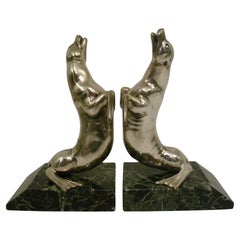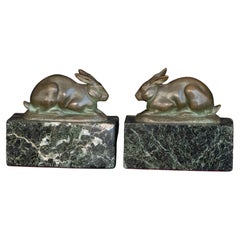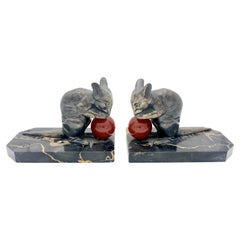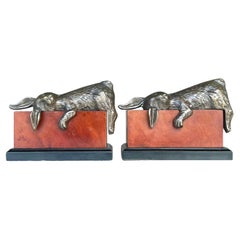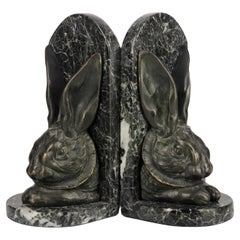Items Similar to Art Deco Gilt Bronze Rabbit Bookends, Edouard-Marcel Sandoz
Want more images or videos?
Request additional images or videos from the seller
1 of 16
Art Deco Gilt Bronze Rabbit Bookends, Edouard-Marcel Sandoz
$3,840per set
$4,800per set20% Off
£2,920.15per set
£3,650.19per set20% Off
€3,368.25per set
€4,210.32per set20% Off
CA$5,379.14per set
CA$6,723.92per set20% Off
A$6,020.32per set
A$7,525.40per set20% Off
CHF 3,143.55per set
CHF 3,929.43per set20% Off
MX$73,448.23per set
MX$91,810.28per set20% Off
NOK 39,903.18per set
NOK 49,878.98per set20% Off
SEK 37,865.66per set
SEK 47,332.08per set20% Off
DKK 25,152.51per set
DKK 31,440.64per set20% Off
Shipping
Retrieving quote...The 1stDibs Promise:
Authenticity Guarantee,
Money-Back Guarantee,
24-Hour Cancellation
About the Item
Art Deco gilt bronze rabbit, hare sculpture bookends - Edouard-Marcel Sandoz. Mounted over Black Belgium marble Bases. Signed Ed. M. Sandoz and Foundry Susse Freres Edition Paris.
Edouard-Marcel Sandoz (1881-1971)
Born in Basle, educated in Switzerland, Edouard Marcel Sandoz worked mainly in Paris, where he settled in 1908. A sculptor of men and of animals, he expressed himself in bronze, in ceramic, and through the direct cutting of stone. A painter of flowers and of landscapes, he was also an unflagging producer of sketches and water-colors.
His motto: “In art, one has to love everything: nature, science, one's fellow man…”
His defining characteristics: intellectual curiosity and technical discipline. His freedom of expression was grounded in mastery of classical and traditional techniques, his knowledge of materials, the constant search for new tools, the opening up of new artistic territories, and the study and profound understanding of his subject-matter.
His very personal style, developed in the course of a long career, bears the imprint of the Art Nouveau period, in which he was a forceful presence. The predominance of animalism in his sculptural work incited him to found the French Society of Animalists in 1933.
His commitment to the service of his fellow artists led him to preside over the Baron Taylor Association for more than thirty years, to found the Charitable Society for Children of Artists, and to contribute to the creation of the Cité des Arts in Paris.
In recognition of his talents and achievements, France elected him a Member of the Academy of Fine Arts, and appointed him to the rank of Commander both of the Legion of Honour and of the Order of Arts and Letters.
We have specialized in the sale of Art Deco and Art Nouveau and Vintage styles since 1995. If you have any questions we are at your disposal. Pushing the button that reads 'View All From Seller'. And you can see more objects to the style for sale. Why are there so many antiques in Argentina?
In the 1880 – 1940 there was a grate wave of immigration encouraged by the periods of war that were taking place. 1st World War took place between 1914 and 1918 2nd World War took place between 1939 and 1945 The immigrants options were New York or Buenos Aires. Tickets were cheap and in Buenos Aires they were welcomed with open arms, as it was a country where everything was still to be done. Argentina was the country of new opportunities, labour was needed and religious freedom was assured, in many cases the of the family travel first until they were settled and then the rest of the family members join them. In the immigrant museum “Ellis Island Immigrant Building” in New York you can se the promotional posters of the boats that would take them to a new life. Between the years 1895 and 1896, Argentina had the highest DGP (gross domestic product) per capita in the world according to the Maddison Historical Statistics index, this situation arose due to the large amount of food being exported to European countries, which were at war. The Argentinean ships left the port of Buenos Aires with food, but they returned with furniture, clothes and construction elements, (it´s common to see this the old buildings of the historic neighbourhood of San Telmo, the beams with the inscription “Made in England)”, as well as many markets that were built in Buenos Aires, such us the San Telmo Market, whose structure was brought by ship and afterwards assembled in 900 Defensa Street. With the great influence of European immigrants living in the country, the children of the upper classes travelled to study in France, resulting in the inauguration of “La Maison Argentinienne”, on 27th of June 1928, in the international city of Paris, which hosted many Argentinians that were studying in Frace. It´s the fourth house to be built after France, Canada and Belgium, being the first Spanish-speaking one. Still in place today (17 Bd Jourdan, 75014, Paris, France). Many of the children of these wealthy families who attended international art exhibitions, museums and art courses abroad, took a keen interest in the European style. This is why Buenos Aires was at the time referred as “The Paris of South America”. Between the years 1890 and 1920 more than a hundred Palaces were built on Alvear Avenue the most exclusive avenue in Buenos Aires. Today some of these palaces have been transformed into museums, hotels and embassies. In the year 1936, the Kavanagh building was inaugurated, it was the tallest reinforced concrete building in South America. During 1994 the American Society of Civil Engineers distinguished it as an “international engineering milestone”, and it´s now considered a World Heritage of Modern Architecture. At the time was common to hire foreign architects such as Le Corbusier, who visited Buenos Aires/Argentina in 1929 and in 1948 he drew up the blueprints for a house built in La Plata City (which was declared a World Heritage Site). In 1947, the Hungarian architect Marcelo Breuer designed “Parador Ariston” in the seaside city of Mar del Plata. After an Argentinean student at Harvard University convinced him to come to Argentina. He worked on an urban development project in the Casa Amarilla, area of La Boca. The Ukrainian architect, Vladimiro Acosta, arrives in Argentina in 1928 and worked as an architect until que moved to Brazil. Antonio Bonet, a Spanish architect who worked with Le Corbusier in Paris, arrives in Argentina in 1937, where he carried out several architectural works and in 1938 designs the well-known BFK chair. Andres Kálnay, of Hungarian origin, made around 120 architectural masterpieces, among which the former Munich brewery stands out, he even made the furniture’s design. The German architect, Walter Gropius, director of the Bauhaus, lived in Argentina, where he wrote articles for “Sur” magazine and founded in Buenos Aires, an architectural firm with Franz Möller, who was also an architect, where he built two houses. At the same time several famous designers decided to immigrate to Argentina, among them we can find the well-known French designer, Jean-Michel Frank, who arrived in the country in 1940 and also worked for the Rockefeller family. Special pieces were made, which were sold exclusively in the country, such as the well-known German company “WMF”, who sold their products by catalogue, which were chosen by the ladies of high society in the list of wedding gifts, as well as the pieces designed by Christofle. The Swiss sculptor Alberto Giacometti, made special pieces for Argentinean mansions. In 1904 the first Jansen branch outside Paris was established in Buenos Aires, as the Argentinean clientele demanded a large amount of furniture, from the end of the 19th century to the mid-20th century. In 1970, the brand Rigolleau Argentina made pieces authorised by Lalique. The brands Maple and Thompson also set up shop in the country. The French plastic artist, Marcel Duchamp moved to Argentina in 1918-1919. Glass signed Gallé, Charder, Leverre, Schneider, Muller and other French firms. They were bought in flower shops and were given to ladies with beautiful floral arrangements. Some furniture manufacturers travelled to international fairs and bough the patterns to produce the furniture in Argentina, such as the furniture firm Englander and Bonta, who bought the patterns in Italy. It is worth mentioning that in Argentina we have the largest community of Italians outside of Italy, as it is estimated that 70 percent of the inhabitants have at least one Italian descendant, followed by Spanish immigrants. The most Important furniture stores in Argentina: Comte is founded in 1934 (under the direct management of Jean Michel Frank in 1940). Nordiska (Swedish company established in 1934). Churba in 1960, a company that brought foreign designers to present their furniture in the country: Denmark: (Arne Jacobsen, Finn Juhl, Bender Madsen, Ejner Larsen, Poul Kjaerholm, Hans Wegner) Sweden: (Hans Agne Jakobsson, Gustavsberg) United States: (Herman Miller) Finland: (Lisa Johansson, Folke Arstrom, Tapio Wirkkala, Alvar Aalto, Timo Sarpaneva) Swedish Factory: (Orrefors) Italy: (Littala, Vico Magistretti, Emma Gismondi, Gae Aulenti, Angelo Mangiarotti, Elio Martinelli, Gianna Celada, Angelo Mangiarotti, Mario Bellini, Carlo Scarpa) Finland: (Olivia Toikka) Plata Lappas (Lappas Silver): a goldsmith shop founded in 1887 in Argentina by Alcibiades Lappas of Greek origin. In 2019, in Argentina took place “the Art Deco world congress” . Argentina currently has more than 100 Art Deco buildings and another 90 Art Nouveau buildings throughout the city of Buenos Aires. Argentina is a country that has not been involved in many wars, which is why it has been a refuge for works of art and antiques from different periods of time, unlike European countries. That is way many collectors, museums and antique dealers from all over the world visit it, you should not miss the opportunity to visit this great country.
- Creator:Susse Freres (Metalworker),Edouard-Marcel Sandoz (Artist)
- Dimensions:Height: 3.55 in (9 cm)Width: 5.12 in (13 cm)Depth: 3.15 in (8 cm)
- Sold As:Set of 2
- Style:Art Deco (In the Style Of)
- Materials and Techniques:Bronze,Silvered
- Place of Origin:
- Period:
- Date of Manufacture:1925
- Condition:Wear consistent with age and use.
- Seller Location:Buenos Aires, AR
- Reference Number:1stDibs: LU2027337598652
Edouard-Marcel Sandoz
Born in Basle, educated in Switzerland, Edouard Marcel Sandoz worked mainly in Paris, where he settled in 1908. A sculptor of men and of animals, he expressed himself in bronze, in ceramic, and through the direct cutting of stone. A painter of flowers and of landscapes, he was also an unflagging producer of sketches and water-colours. His motto : “ In art, one has to love everything : nature, science, one's fellow man… ” His defining characteristics : intellectual curiosity and technical discipline. His freedom of expression was grounded in mastery of classical and traditional techniques, his knowledge of materials, the constant search for new tools, the opening up of new artistic territories, and the study and profound understanding of his subject-matter. His very personal style, developed in the course of a long career, bears the imprint of the Art Nouveau period, in which he was a forceful presence.The predominance of animalism in his sculptural work incited him to found the French Society of Animalists in 1933. His commitment to the service of his fellow artists led him to preside over the Baron Taylor Association for more than thirty years, to found the Charitable Society for Children of Artists, and to contribute to the creation of the Cité des Arts in Paris. In recognition of his talents and achievements, France elected him a Member of the Academy of Fine Arts, and appointed him to the rank of Commander both of the Legion of Honour and of the Order of Arts and Letters.
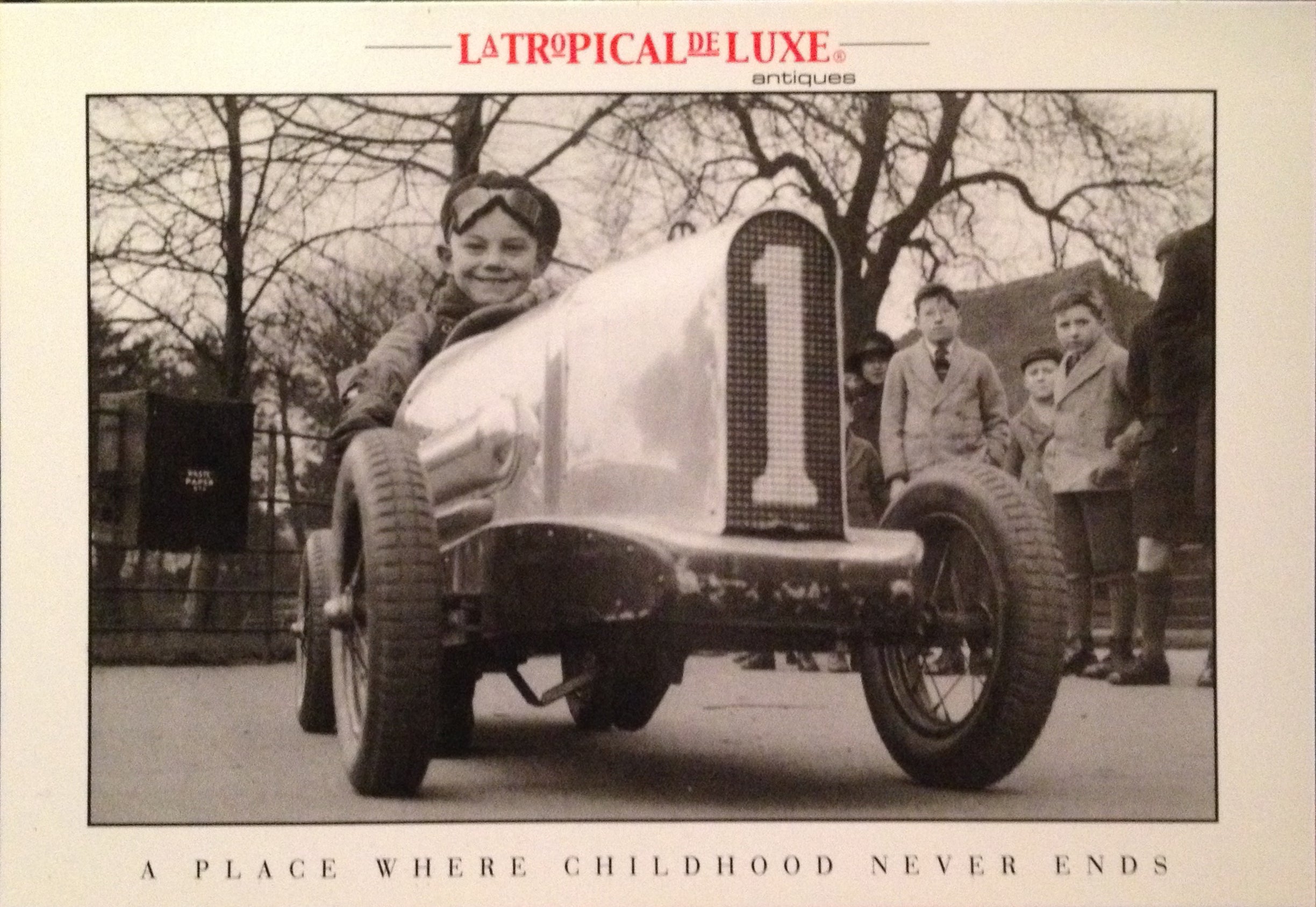
About the Seller
4.9
Vetted Professional Seller
Every seller passes strict standards for authenticity and reliability
Established in 2002
1stDibs seller since 2016
320 sales on 1stDibs
Typical response time: 1 hour
- ShippingRetrieving quote...Shipping from: Buenos Aires, Argentina
- Return Policy
Authenticity Guarantee
In the unlikely event there’s an issue with an item’s authenticity, contact us within 1 year for a full refund. DetailsMoney-Back Guarantee
If your item is not as described, is damaged in transit, or does not arrive, contact us within 7 days for a full refund. Details24-Hour Cancellation
You have a 24-hour grace period in which to reconsider your purchase, with no questions asked.Vetted Professional Sellers
Our world-class sellers must adhere to strict standards for service and quality, maintaining the integrity of our listings.Price-Match Guarantee
If you find that a seller listed the same item for a lower price elsewhere, we’ll match it.Trusted Global Delivery
Our best-in-class carrier network provides specialized shipping options worldwide, including custom delivery.More From This Seller
View AllArt Deco Hare / Rabbit bookends designed by Becquerel. France 1920´s
By André Vincent Becquerel
Located in Buenos Aires, Olivos
Art Deco hare or rabbit bookends designed by A. Becquerel and signed by foundry Etling Paris.
1920s. Very nice animal sculptures.
We have specialized ...
Category
Vintage 1920s French Art Deco Bookends
Materials
Bronze
Art Deco Rabbit, Hare Silver Plated Bronze Bookends, A.E.L, 1920s
By A.E.L.
Located in Buenos Aires, Olivos
Very nice Art Deco rabbit, hare silver plated bronze bookends. Signed A.E.L. , stamped France and 28. Mounted Over Russian Onix.
We have specialized i...
Category
Early 20th Century French Art Deco Animal Sculptures
Materials
Brass
Art Deco Turkey Bronze Bookends Signed Irenee Rochard
By Irénée Rochard
Located in Buenos Aires, Olivos
Art Deco Turkey bronze bookends signed Irenee Rochard. Very nice with original patina, mounted over marble bases.
Irénée René Rochard (French, 1906 ~ 19...
Category
Vintage 1920s French Art Deco Animal Sculptures
Materials
Bronze
Art Deco Seal Bookends Louis Albert Carvin France 1930
By Louis-Albert Carvin
Located in Buenos Aires, Olivos
Nice pair of Art Deco seal bookends designed by the French artist Louis Albert Carvin, silvered white metal on a green marble base, France, 1930.
“Anima...
Category
Early 20th Century French Art Deco Animal Sculptures
Materials
Marble, Metal
Paul Silvestre French Art Deco Bronze Lamb Bookends
By Susse Freres, Paul Silvestre
Located in Buenos Aires, Olivos
Art Deco bronze lamb bookends. Paul Silvestre.
Marked: Silvestre, foundry mark, Susse Frères, Paris.
Literature:
This model is illustrated in
"Animals in ...
Category
Early 20th Century French Art Deco Bookends
Materials
Bronze
Pair of art deco bookends Cat playing with a Ball. France 1925
Located in Buenos Aires, Olivos
Pair of art deco bookends Cat playing with a Ball. France 1925
Nice pair of Art Deco bookends with sculptures of cats playing what a ball. Made of silvered bronze, on marble bases. ...
Category
Early 20th Century French Art Deco Bookends
Materials
Marble, Bronze
You May Also Like
Pair of Art Deco Austrian Bronze Rabbits Signed R. Desset
Located in San Francisco, CA
Pair of Art Deco Austrian Bronze Rabbits Signed R. Desset
Each rabbit mounted on a block of variegated green serpentine marble.
Rabbits are ea...
Category
Vintage 1920s Austrian Art Deco Animal Sculptures
Materials
Bronze
Antique Art Deco Sculpture Mice Signed H. Moreau Metal Bakelite Marble Bookends
By Hippolyte François Moreau
Located in Munich, DE
The two beautiful mice have been cast out of spelter and are silver plated. The little creatures are playing with a deep red ball made out of bakelite. Mice and balls are mounted on...
Category
Vintage 1920s French Art Deco Animal Sculptures
Materials
Marble, Metal
Vintage Boho Patinated Bronze Rabbits on Leather Blocks Bookends - Set of Two
Located in West Palm Beach, FL
Discover an enchanting touch for your curated collection with this exquisite pair of Vintage Boho Patinated Bronze Rabbits on Leather Blocks Bookends. Each bookend features a charmin...
Category
Late 20th Century American Rustic Bookends
Materials
Bronze
Pair of Victorian Bronze Rabbit Head Bookends in Marble Plinths by A. Gilbert
By Sir Alfred Gilbert
Located in North Miami, FL
Pair of late 19th century Victorian bronze rabbit head bookends in marble plinths by Sir Alfred Gilbert
By: Sir Alfred Gilbert
Material: bronze, marble, copper, metal
Technique: cas...
Category
Antique Late 19th Century English Victorian Bookends
Materials
Marble, Bronze, Metal, Copper
Art Deco Squirrel Bookends by Max Le Verrier Largest Size France 1930 Original
By Max Le Verrier
Located in Antwerp, BE
Art Deco squirrel bookends by Max Le Verrier.
The sculptures are in Art metal with green patina with brown shades
They stand on Belgina Black marble bases.
France 1930.
This size is...
Category
Vintage 1930s French Art Deco Animal Sculptures
Materials
Marble, Metal
Pair of Art Deco Ibex Bookends signed Franjou (Hippolyte Moreau)
By Franjou
Located in SAINTE-COLOMBE, FR
Pair of Art Deco Ibex Bookends signed Franjou (Hippolyte Moreau)
An attractive pair of matching Art Deco bookends signed Franjou, pseudonym of the famous French sculptor Hippolyte ...
Category
Early 20th Century French Art Deco Bookends
Materials
Marble, Spelter
More Ways To Browse
Marcel Duchamp Signed
Marcel Antique Chairs
Lalique Bronze
Scarpa Bronze
Hans Muller Bronze
Antique South American Sculpture
Rabbit Italy
Bronze Boat Sculpture
1880s Bronze Sculptures
Art Deco 1925 Poster
Christofle Service
Bronze Susse
Susse Freres Bronze
Bronze Rabbit
Italian Marble Bookends
Breuer Long Chair
Bear Marble Sculpture
Paris Bookends
